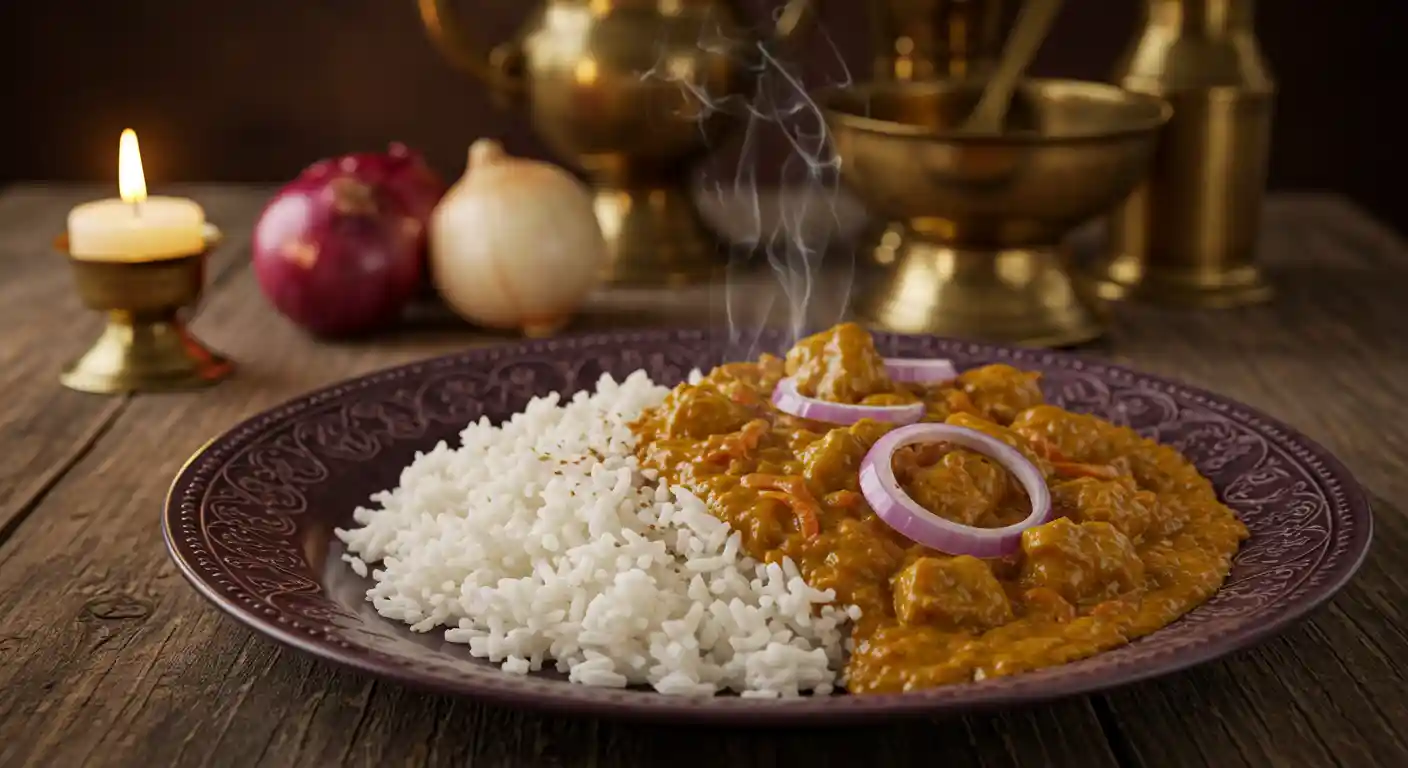Terra Massoud Recipe is a flavorful and hearty dish, often regarded as a culinary treasure in Middle Eastern cuisine. Known for its rich textures and complex flavors, it features a harmonious blend of grains, meat, and aromatic spices. The terra massoud recipe traditionally includes slow-cooked ingredients, creating a savory and satisfying experience with every bite. The layers of tender meat or vegetables soak up the robust flavors of the sauce, which is typically infused with herbs and spices. Whether enjoyed as a festive meal or a comforting dish for any occasion, mastering the terra massoud recipe is sure to elevate any dining experience.
Table of Contents
Why Terra Massoud is a beloved dish
Terra Massoud is a beloved dish due to its captivating combination of flavors and textures that appeal to the senses. The dish’s ability to blend tender grains with savory meat and spices creates an unforgettable experience. What truly makes it cherished is its versatility—whether served at large gatherings or intimate meals, it brings comfort and satisfaction. The complexity of the terra massoud recipe, with its carefully balanced seasonings and slow-cooked elements, showcases the depth of Middle Eastern culinary traditions. Its rich heritage and the hearty nature of the dish continue to make terra massoud a timeless favorite among food enthusiasts.
The benefits of making it at home
Making terra massoud at home offers numerous advantages that elevate the culinary experience. First, preparing it yourself allows for complete control over the quality and freshness of ingredients. You can customize the terra massoud recipe to suit your specific taste preferences, adjusting spices and seasonings for the perfect balance. Homemade versions also tend to be more cost-effective compared to dining out, without sacrificing flavor or authenticity. Additionally, the process of crafting this dish at home connects you to its cultural heritage, providing a deeper appreciation for its complexity. Ultimately, making terra massoud yourself results in a more personal, rewarding meal.
A glimpse into the flavors and textures of Terra Massoud
The flavors and textures of terra massoud are a delightful symphony of savory, aromatic, and rich elements. The base, often made from grains, provides a delicate yet hearty foundation, absorbing the flavors of the slow-cooked meat or vegetables. The spices—warm, earthy, and subtly sweet—infuse the dish with depth. Each bite offers a satisfying contrast between tender ingredients and the comforting smoothness of the sauce. With the terra massoud recipe, you experience layers of flavor that evolve on the palate, from the initial warmth of the spices to the lingering richness that lingers long after the last bite.
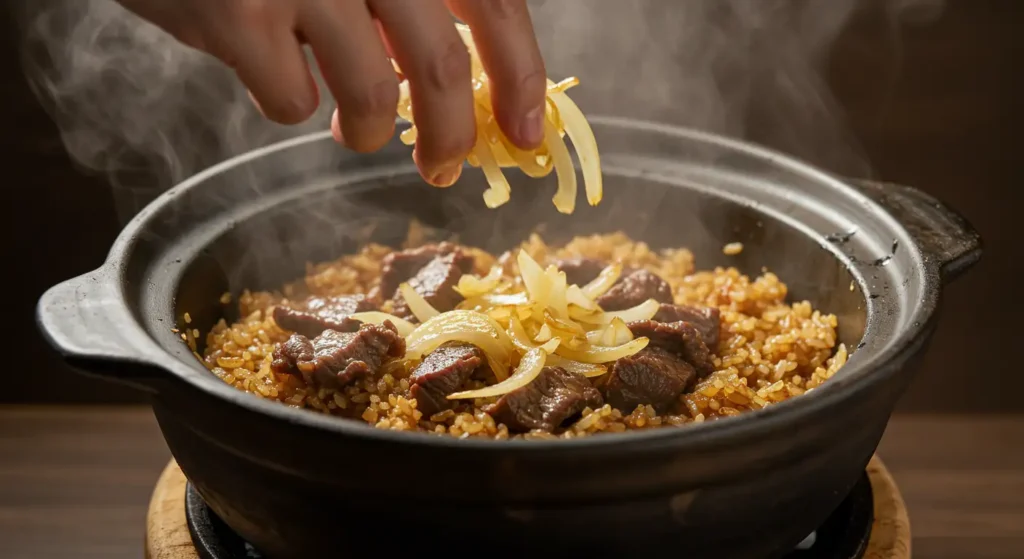
Essential Ingredients for Terra Massoud
The star ingredients: Grains, meats, and spices
The heart of any exceptional terra massoud recipe lies in its star ingredients: grains, meats, and spices. The grains, often rice or bulgur, form the hearty base, offering a delicate chew that absorbs the flavors of the accompanying ingredients. The choice of meat—typically lamb or chicken—adds richness and depth, its tenderness enhanced through slow cooking. Spices are the true soul of the dish, with cumin, coriander, and cinnamon weaving a warm, aromatic tapestry. The balance of these ingredients creates a dish that is both comforting and complex, inviting layers of flavor with every bite.
Understanding the role of herbs and spices in creating depth
Herbs and spices are essential to the complexity and depth of flavor in a terra massoud recipe. These aromatic elements not only enhance the dish’s taste but also create a harmonious balance between its components. Spices like cumin and cinnamon lend warmth, while coriander and turmeric introduce subtle earthy undertones. Fresh herbs, such as cilantro or parsley, provide brightness, cutting through the richness of the meat and grains. Together, these ingredients don’t just season—they infuse the entire dish with layers of flavor, transforming a simple meal into a deeply satisfying culinary experience. The careful use of herbs and spices is key to achieving this depth.
Finding fresh, authentic ingredients locally
Finding fresh, authentic ingredients locally is crucial when crafting an exceptional terra massoud recipe. Sourcing high-quality grains, meats, and spices ensures the dish’s flavors are as rich and vibrant as intended. Look for specialty stores or farmers’ markets that offer fresh herbs and spices, as these provide the aromatic depth that makes the dish so distinctive. Locally sourced, free-range meats also contribute to a more tender and flavorful outcome. While some ingredients may be more challenging to find, taking the time to search for authentic, fresh components elevates the entire experience and brings an undeniable authenticity to your terra massoud recipe.
Substituting ingredients for dietary preferences (vegetarian, gluten-free)
Adapting the terra massoud recipe to accommodate dietary preferences is both simple and rewarding. For a vegetarian version, swap the traditional meat with hearty vegetables, such as mushrooms or eggplant, which mimic the dish’s rich texture and absorb the spices beautifully. To make the dish gluten-free, replace any wheat-based grains with rice, quinoa, or millet, all of which provide a similar consistency and flavor. With the right substitutions, the essence of the terra massoud recipe remains intact, offering a delicious and inclusive meal without compromising on authenticity. Customizing ingredients ensures everyone can enjoy this comforting dish.
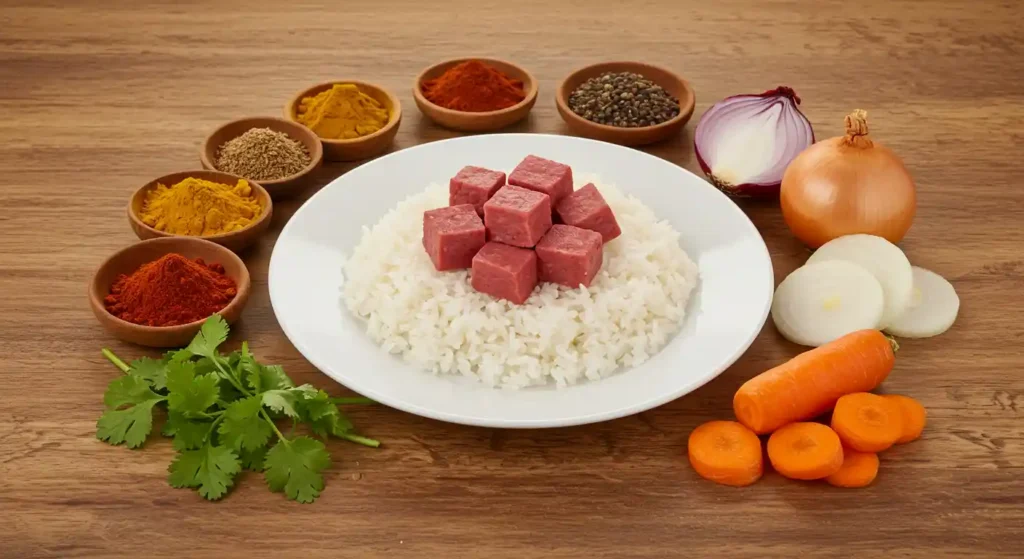
Preparing the Base: A Crucial First Step
Cooking the grains to perfection: Techniques for fluffiness and texture
Cooking the grains to perfection is essential for achieving the ideal texture in a terra massoud recipe. The grains should be light, fluffy, and not overly sticky. Begin by rinsing the grains thoroughly to remove excess starch. For extra fluffiness, use a ratio of 1:1.5 grains to water, allowing for just enough moisture to cook the grains evenly. Once the water reaches a boil, reduce the heat to a simmer and cover the pot, ensuring the grains are cooked slowly and gently. For added richness, some prefer to cook the grains in broth, which enhances their flavor and gives them a tender, melt-in-your-mouth texture.
How to achieve the ideal consistency for the base
Achieving the ideal consistency for the base in a terra massoud recipe is key to creating a balanced and satisfying dish. The base should have a smooth, slightly creamy texture, without being overly watery or dry. To achieve this, start by cooking the grains to the perfect tenderness, ensuring they absorb enough moisture but remain separate. When preparing the sauce, use a careful balance of liquid and cooking time to thicken it naturally. A gentle simmer allows the flavors to meld and the sauce to reduce, creating the perfect consistency that complements the grains without overpowering them in the final terra massoud recipe.
Preparing the right kind of stock for rich flavor
Preparing the right kind of stock is essential for infusing the terra massoud recipe with rich, deep flavor. Begin by selecting a high-quality stock—whether meat-based, such as chicken or beef, or vegetable-based for a lighter alternative. The key is to simmer the stock for hours, allowing it to reduce and concentrate, intensifying its natural flavors. Aromatics like onions, garlic, and herbs should be added to enhance the complexity. Using this flavorful stock as a cooking liquid for the grains and sauce ensures that each component of the terra massoud recipe absorbs a depth of taste, elevating the entire dish.
Balancing moisture for a perfect base
Balancing moisture is crucial for achieving a perfect base in a terra massoud recipe. Too much liquid can leave the grains soggy, while too little results in a dry, uneven texture. To find the right balance, carefully measure the cooking liquid, whether it’s broth or water, ensuring that it just covers the grains. During the cooking process, it’s essential to monitor the moisture levels, adjusting as needed by adding small amounts of liquid to prevent burning or dryness. By maintaining this delicate equilibrium, the grains absorb just enough moisture, creating a tender, flavorful base that supports the richness of the entire terra massoud recipe.
Creating the Flavorful Terra Massoud Sauce
The foundation of the sauce: Key components and spices
The foundation of the sauce in a terra massoud recipe lies in its rich blend of key components and spices. The base often starts with onions, garlic, and tomatoes, sautéed to create a savory depth. Spices such as cumin, coriander, and cinnamon are crucial for infusing warmth and complexity, while turmeric and saffron add subtle layers of flavor and vibrant color. To enhance the sauce’s richness, a touch of broth or stock is added, allowing the ingredients to meld together. The balance of these components creates a harmonious sauce that complements the grains and meat, making the terra massoud recipe unforgettable.
How to season the sauce to achieve the perfect balance of sweet, salty, and savory
Seasoning the sauce to achieve the perfect balance of sweet, salty, and savory is key in a terra massoud recipe. Begin with the natural sweetness of caramelized onions and tomatoes, which provide a subtle foundation. To balance this, incorporate salt—preferably sea salt or Himalayan pink salt—to elevate the flavors. For depth, add spices like cumin, cinnamon, and a touch of black pepper, which bring savory complexity to the sauce. A hint of sugar or honey can amplify the sweetness, while a dash of lemon or vinegar introduces acidity, creating contrast. Mastering this balance ensures the sauce is vibrant and well-rounded, perfectly complementing the grains and meat in the terra massoud recipe.
The importance of slow-cooking the sauce to develop deep flavors
Slow-cooking the sauce is essential in a terra massoud recipe to develop deep, layered flavors. As the sauce simmers over low heat, the ingredients have time to meld together, allowing the spices, herbs, and aromatics to release their full potential. This gradual cooking process enhances the richness, infusing the sauce with a complexity that quick cooking cannot achieve. The slower the cooking time, the more the flavors concentrate and evolve, creating a harmonious blend that enhances every bite. This method ensures that each element of the terra massoud recipe is tender, flavorful, and perfectly balanced.
Variations on the traditional sauce for personalized twists
Variations on the traditional sauce in a terra massoud recipe offer the opportunity to add personalized twists, enhancing both flavor and texture. To create a spicier version, consider incorporating chili peppers or harissa for a bold kick. For a more herbal note, infuse the sauce with fresh mint or parsley, which brightens the richness of the dish. You can also experiment with adding dried fruits like raisins or apricots for a touch of sweetness that contrasts beautifully with the savory elements. These variations allow the terra massoud recipe to be tailored to different tastes, making the dish uniquely your own.
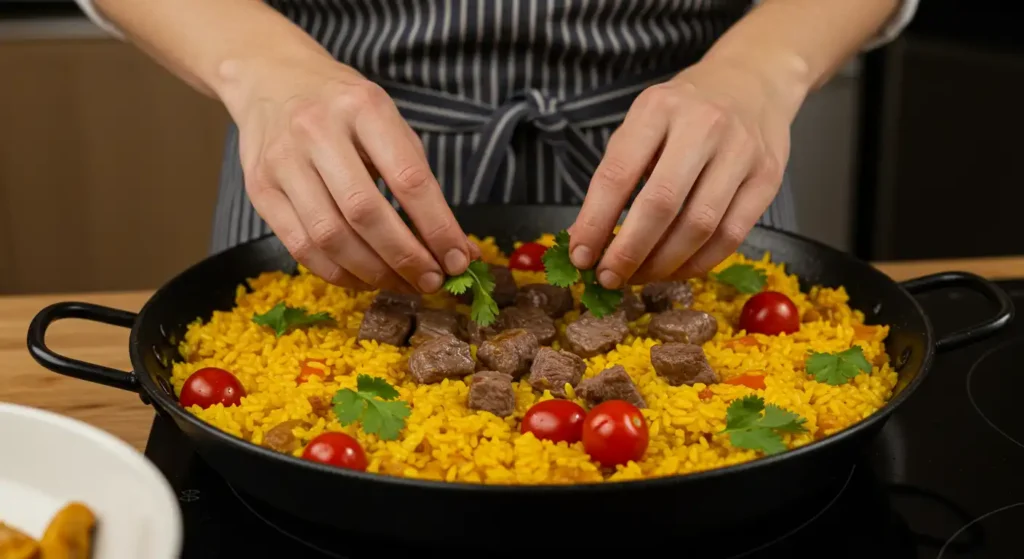
Cooking the Meat or Vegetarian Alternative
Choosing the right cut of meat for authenticity and flavor
Choosing the right cut of meat is crucial for both authenticity and flavor in a terra massoud recipe. Traditional cuts like lamb shoulder or leg are ideal for their tenderness and ability to absorb rich spices during slow cooking. The marbling of fat in these cuts enhances flavor, infusing the dish with a savory depth that leaner meats cannot replicate. For a slightly lighter version, chicken thighs offer a juicy alternative, maintaining that same richness when slow-cooked. Selecting the proper meat ensures the terra massoud recipe stays true to its roots, delivering a hearty, flavorful experience with each bite.
Tips for cooking meat to tenderness without losing juiciness
To achieve tender, juicy meat in a terra massoud recipe, slow cooking is essential. Start by browning the meat to develop flavor, then cook it at a low temperature for an extended period. This process breaks down the connective tissue, resulting in tender cuts without sacrificing moisture. Basting the meat periodically with its own juices or broth can help maintain its moisture throughout the cooking. For added juiciness, consider marinating the meat beforehand, as this infuses it with flavor and helps retain moisture during cooking. By using these techniques, the meat in your terra massoud recipe will be succulent and full of flavor.
Creating a vegetarian or vegan version that mimics the texture of meat
Creating a vegetarian or vegan version of a terra massoud recipe that mimics the texture of meat requires thoughtful substitutions. Mushrooms, particularly portobello or shiitake, provide a hearty, meaty texture when sautéed, absorbing the rich spices and flavors of the dish. For a protein-packed alternative, tempeh or seitan can be used, as they offer a satisfying chewiness and the ability to soak up the sauce. Tofu, when pressed and marinated, can also replicate the tender texture of slow-cooked meat. By selecting these plant-based ingredients and seasoning them well, you can craft a terra massoud recipe that’s both satisfying and full of depth.
How to season and marinate for optimal flavor
Seasoning and marinating are key to unlocking optimal flavor in a terra massoud recipe. Start by combining aromatic spices such as cumin, coriander, and paprika with a base of olive oil, lemon juice, or yogurt to create a robust marinade. This mixture not only imparts deep flavor but also tenderizes the meat or its plant-based substitutes. Allow the ingredients to marinate for several hours, or ideally overnight, to let the spices penetrate deeply. Don’t forget to add a pinch of salt to enhance the overall taste profile. Proper seasoning and marinating elevate the terra massoud recipe into a culinary masterpiece.
Assembling and Layering the Terra Massoud
Properly layering the base and sauce for even flavor distribution
Layering the base and sauce is a crucial step in a terra massoud recipe to ensure even flavor distribution. Begin by spreading a portion of the sauce on the bottom of the dish to create a foundation of moisture and seasoning. Add the base, such as grains or vegetables, in an even layer, then follow with another generous portion of sauce. Repeat this process, ensuring each layer is balanced and well-coated. This technique allows the flavors to permeate every bite, creating a harmonious blend. Proper layering in the terra massoud recipe transforms the dish into a well-structured and flavorful masterpiece.
Tips for achieving the perfect balance between grains and sauce
Achieving the perfect balance between grains and sauce in a terra massoud recipe is essential for a cohesive dish. Start by measuring your grains carefully; too much can overwhelm the sauce, while too little leaves the dish unbalanced. The grains should absorb the sauce without becoming overly saturated, retaining their texture. Add the sauce gradually, mixing thoroughly after each addition to ensure even coating. Monitor the consistency, aiming for grains that are moist but not swimming in liquid. Taste frequently to adjust seasoning and ensure harmony. Balancing these elements ensures your terra massoud recipe delivers depth and a satisfying texture.
How to assemble the dish for maximum visual appeal
Assembling a terra massoud recipe with maximum visual appeal requires attention to detail and thoughtful presentation. Begin by layering the dish in a wide, shallow serving platter to showcase the textures and colors. Arrange the grains evenly as the base, followed by artfully spooning the sauce over the top to highlight its richness. Garnish with fresh herbs, such as parsley or cilantro, for a vibrant contrast. Add a sprinkle of toasted nuts or seeds for texture and a decorative finish. Consider symmetry and color balance for an enticing look. A well-assembled terra massoud recipe delights both the eyes and the palate.
The role of layering in enhancing the dish’s flavors
Layering plays a pivotal role in amplifying the flavors of a terra massoud recipe, creating a harmonious blend of taste and texture. By alternately adding grains, sauce, and additional elements, each layer absorbs and complements the others, ensuring consistent seasoning throughout. This technique allows the sauce to infuse the base with its rich complexity while maintaining the integrity of individual ingredients. Proper layering also creates depth, with each bite offering a symphony of flavors that evolve as you eat. The method is both practical and artistic, transforming a terra massoud recipe into a multidimensional culinary experience.
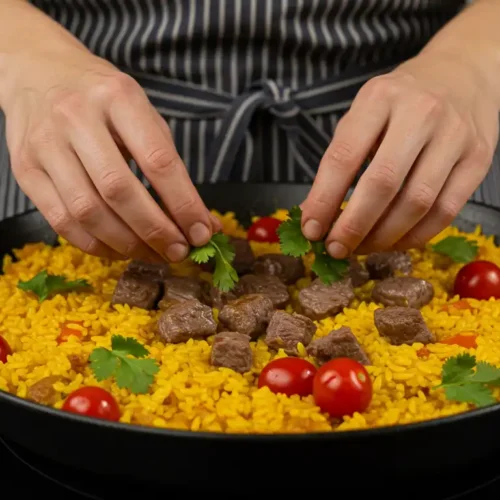
How to Make the Perfect Terra Massoud Recipe at Home
Ingredients
- 2 pounds lamb or beef cut into 1-inch cubes
- 2 cups long-grain basmati rice
- 4 large onions thinly sliced
- 2 teaspoons ground cumin
- 2 teaspoons ground coriander
- 1 teaspoon ground turmeric
- ½ teaspoon ground cardamom or 4–5 whole green cardamom pods
- Salt and black pepper to taste
- 3 tablespoons olive oil or ghee
- 1 cup warm water
- Fresh cilantro or parsley chopped (for garnish)
- Toasted slivered almonds raisins, or plain yogurt (optional, for serving)
Instructions
- Season meat with salt and pepper.
- Caramelize onions in oil/ghee until golden brown; set half aside.
- Sear meat with remaining onions until browned; set aside.
- Rinse rice, add to pot with water and salt; simmer for 7-8 minutes, then drain.
- Layer half the rice, meat, caramelized onions, spices and then the rest of the rice in a pot
- Add 1 cup of warm water, cover, and slow cook on low heat for 2-3 hours.
- Rest for 10-15 minutes before serving.
- Garnish with fresh herbs, almonds, or yogurt if desired.
Notes
- For best results, use high-quality meat and fresh spices.
- Don’t rush the caramelizing process for the onions; low and slow is key.
- Properly rinsing the rice is crucial to prevent it from becoming mushy.
- Slow cooking is essential to develop the depth of flavor and tenderize the meat.
Serving Suggestions and Pairings
Traditional and modern ways to serve Terra Massoud
Serving a terra massoud recipe can reflect either traditional customs or modern culinary trends, offering versatility for any occasion. Traditionally, the dish is presented family-style on a large platter, with the grains forming a foundation and the sauce elegantly draped over the top. It’s often garnished with fresh herbs, nuts, or dried fruits, enhancing its visual and flavorful appeal. Modern interpretations might include individual portions plated with artistic precision, emphasizing aesthetics and portion control. Some opt for layered jars or bowls for casual gatherings, blending convenience with sophistication. Both methods celebrate the rich heritage and adaptability of the terra massoud recipe.
Best side dishes that complement the rich flavors of Terra Massoud
Pairing the terra massoud recipe with thoughtfully chosen side dishes elevates its rich flavors to new heights. A crisp, tangy salad featuring fresh greens, citrus, and a light vinaigrette provides a refreshing contrast to the dish’s hearty profile. Warm, pillowy flatbreads or buttery, herb-infused rice pilaf complement the savory depth of the sauce and grains. For a touch of sweetness, roasted root vegetables glazed with honey and spices add balance to the meal. Yogurt-based dips, such as tzatziki or spiced raita, bring cooling elements that harmonize beautifully with bold spices. Each pairing enhances the terra massoud recipe experience.
Pairing drinks with Terra Massoud for a complete meal
Pairing the perfect drink with the terra massoud recipe completes the culinary experience. A robust red wine, such as Syrah or Malbec, complements the dish’s deep, spiced flavors with its rich tannins and fruity undertones. For non-alcoholic options, a spiced herbal tea, infused with cardamom and cinnamon, mirrors the warm notes of the dish. Sparkling water with a hint of lemon or mint refreshes the palate, balancing the hearty base. Craft beers, especially amber ales or spiced lagers, offer a malty complexity that pairs seamlessly. Thoughtful beverage choices enhance the terra massoud recipe, creating a harmonious and satisfying meal.
Presentation ideas to make your Terra Massoud visually appealing
Enhancing the presentation of your terra massoud recipe elevates the dining experience. Serve the dish on a large, flat platter to showcase its layers and textures. Garnish with finely chopped herbs like parsley or cilantro for a fresh, vibrant contrast. Sprinkle toasted nuts or seeds across the top to add visual intrigue and a hint of crunch. Arrange colorful accompaniments, such as roasted vegetables or pickled garnishes, around the edges for a pop of color. For a refined touch, drizzle a thin line of sauce or yogurt in an artful pattern. These elements transform the terra massoud recipe into a feast for the eyes.
Troubleshooting Common Issues
How to fix under-seasoned or bland Terra Massoud
Reviving an under-seasoned terra massoud recipe requires careful adjustments. Begin by tasting the dish to identify what’s missing. Add a pinch of salt to enhance the existing flavors, but proceed incrementally to avoid over-salting. Incorporate aromatic spices like cumin, coriander, or a touch of smoked paprika to deepen the flavor profile. A splash of lemon juice or a dash of vinegar can add brightness and balance. For richness, stir in a bit of melted butter or cream. If sweetness is lacking, a drizzle of honey or a pinch of sugar can work wonders. Adjust layer by layer for a harmonious result.
Dealing with soggy grains or sauce that’s too thick
If the grains in your terra massoud recipe have become soggy, you can salvage them by draining excess moisture and gently reheating them in a dry pan. Stirring occasionally will help restore their texture. If the sauce is too thick, thin it out by adding a small amount of stock, water, or even a splash of white wine. Stir constantly to ensure the sauce integrates smoothly with the grains. To avoid these issues in the future, monitor the cooking time and liquid ratio closely. A delicate balance ensures the dish retains its intended flavor and consistency.
Adjusting the texture of the dish if it becomes too dry or too watery
If your terra massoud recipe turns out too dry, you can rehydrate the dish by gradually adding a splash of stock, water, or even a dash of olive oil. Stir gently and allow the liquid to absorb into the grains and sauce. On the other hand, if the dish becomes too watery, simply increase the heat to evaporate the excess liquid, stirring occasionally to prevent sticking. For optimal results, monitor the cooking process and adjust the liquid levels according to the desired texture. These minor tweaks can help you achieve the perfect consistency every time.
What to do if you’ve overcooked the meat or base
If you’ve overcooked the meat or base in your terra massoud recipe, don’t worry—there are ways to salvage it. For overcooked meat, try shredding it and incorporating it back into the dish with added moisture, such as a flavorful broth or sauce. This can help reintroduce tenderness and juiciness. If the base is too dry or tough, gently stir in a small amount of liquid to revive the texture. To further elevate the dish, consider adjusting the seasoning to balance the flavors, ensuring the final result remains satisfying.
Frequently Asked Questions
Is it possible to use a different meat variety?
Yes, you can substitute the meat in this recipe with other options such as chicken, lamb, or beef, depending on your preference. Make sure to adjust cooking times accordingly for different types of meat. For a vegetarian version, consider using plant-based protein alternatives like tofu or tempeh.
Can this recipe be adapted for a slow cooker?
Yes, this recipe can be made in a slow cooker. Simply add the ingredients, set it to cook on low for several hours, and adjust the cooking time depending on the meat’s tenderness. Keep in mind that you may need to sauté some ingredients beforehand to enhance the flavors.
Can I store the leftovers in the freezer?
Yes, leftovers can be stored in the freezer for up to 3 months. Ensure the dish is completely cooled before transferring it to an airtight container for freezing. Reheat thoroughly when ready to serve for the best taste and texture.
What exactly is ghee, and can I replace it with something else?
Ghee is clarified butter, commonly used in Indian and Middle Eastern cooking for its rich flavor and high smoke point. You can substitute ghee with regular butter or olive oil, though the taste may differ slightly. Coconut oil is a good choice for a dairy-free alternative.
Is basmati rice a must for this recipe?
Basmati rice is not strictly necessary, but it is the preferred choice due to its aromatic flavor and fluffy texture. You can use other types of rice, such as jasmine or long-grain, though the taste and texture will differ slightly. Ensure to adjust cooking times based on the rice variety used.
the perfect Terra Massoud at home is a rewarding and delicious experience that can be customized to suit your preferences. Whether you’re using a different meat, adapting the recipe for a slow cooker, or experimenting with substitutions like ghee or rice varieties, the end result will still be a flavorful, satisfying dish. Don’t hesitate to get creative with your cooking—this versatile recipe is sure to impress, and the leftovers are just as delightful! We hope you enjoy preparing Terra Massoud and that it becomes a cherished part of your meal rotation. Happy cooking!

